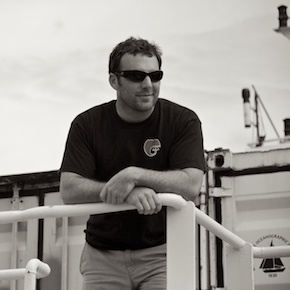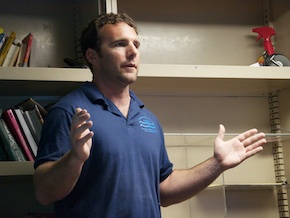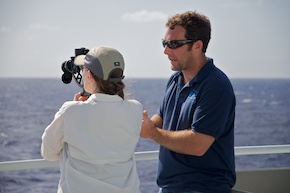The R/V Thomas G. Thompson left Honolulu on November 5, 2011 heading toward the Western Pacific. This expedition journal was written by cruise participants and uploaded about once per weekday, depending on internet availability.
November 29, 2011: Captain Patrick Donovan: “Just a Sailor”

O captain, our captain (Credit: Will Koeppen)
Who is the man in charge? What is he like? What does he do? These questions come to mind when you begin to wonder about the master of the R/V Thomas G. Thompson. The master of the vessel during our research on the Jurassic Quiet Zone is Captain Patrick Donovan. Captain Donovan gave me the opportunity to sit down with him and ask questions to get an understanding of who he is and what it takes to be a captain.
We began our interview by talking about what being a captain is like. Patrick explained that it is a job with a great deal of responsibility. He said that the long process of training and certification to obtain a Maritime Master License helps to prepare you for the responsibility of being the head of the ship. He also said the position is also a lot like being a teacher. Being the master of a vessel allows Patrick to teach and train mates to help them obtain higher maritime licenses. Patrick likes that his position puts him in the middle of everything and in situations where his decisions will help obtain a positive outcome. He also likes that he gets to be involved with all of the aspects of the ship and isn’t just responsible for a particular aspect of making the ship work. When asked about what he likes least about being in his position, he jokingly said that people are reluctant to sit with him at lunch (which was definitely true in my experience).
Captain Patrick grew up with the sea in Newport, Rhode Island. He began taking sailing classes and racing smaller sailboats when he was eight years old. The sea also runs in his family. His grandfather was an engineer in the Navy during World War II before returning stateside and becoming a firefighter. His father also became a firefighter and eventually the Fire Chief for Newport. With a history of firefighting, Patrick thought he might follow in his grandfather and father's footsteps, but he found that he loved the sea and wanted to play with boats instead.

Now he teaches (Credit: Will Koeppen)
Patrick’s path to Maritime Master began at the Massachusetts Maritime Academy, where he graduated with a Bachelor’s degree in Maritime transport. The long certification process includes tremendous amounts of sea time with lots of training and testing. He pulled out his binder of certifications that were required for each maritime license and flipped through the pages while reading off some of the titles: medical and safety training, radar and navigation, flashing light and flag communication, celestial navigation, hazardous chemical transport safety, drug and alcohol safety, drug testing training, safety officer training, maritime firefighting, and small arms training. Behind each of these certifications is hours of class, testing, simulations, and practical application.
When the certification process is finished, you still need a year of hands-on experience on a vessel to get a maritime license. Each time you want to obtain a higher license, for example third to second mate, you need another year of ship time. After going through this seemingly endless process, Patrick now holds an unlimited Maritime Master Certification, which means that he is able to be the master of any vessel on any ocean. Even then, there is navigation recertification every five years in order to keep his maritime license. Even then, he has to be recertified every five years for navigation in order to keep his maritime license. Even though it was a long haul, Patrick said that it was very rewarding, and it is clear that he loves his job.
At age 32, Patrick has been the master of a vessel for about a year. Before working on the Thompson, he worked commercially with oil companies such as Chevron, transporting oil and chemicals. This line of work is completely different from commanding a research vessel. Patrick said that commanding the Thompson has less industry pressure and less risky decision making with more control over the ship. There is also less oversight and paperwork than on a commercial vessel. This allows for more flexibility for the science team to conduct studies the way they need to.

Navigation basics (Credit: Will Koeppen)
After learning about the long process to become a captain and what is it like to command the Thompson, I needed to know what Patrick did in his free time to have fun and relax. He actually does not stray too far from the sea when he is not commanding a vessel. He works six months a year at sea and spends the other six racing sailboats in competitions and spending quality time with his wife and two children in Newport. He said that it is difficult to be away from his family for one to two months at a time, but with new technology like satellite internet, it makes it easier to stay in touch. When I asked him if he gets tired of being on the water constantly, he said that you do what you love and he loves boats and all things nautical.
This wrapped up our conversation, which ended with Patrick saying that if I ever had any questions, suggestions, or just wanted to talk, the door to his office/stateroom was always open. About an hour after our conversation, Patrick gave a lecture and demonstration on celestial navigation. He taught us the theory behind navigating with the sun and stars and then showed us how to figure out where we were in the world using a sextant, the horizon, and the sun. When asked by the chief scientist if, in the case of a catastrophic failure of all our GPS equipment, he could navigate us to Guam using just celestial navigation, he said yes, he could easily do it. This proved to me that Captain Patrick can get us anywhere we need to go, no matter what. ♦
